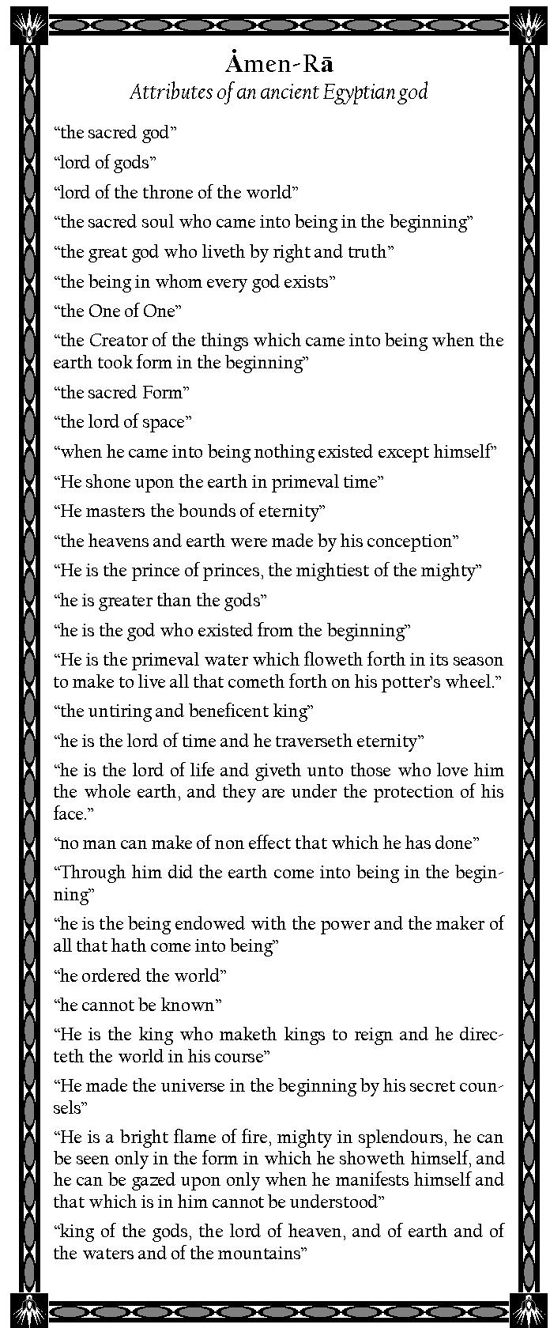AMEN

By: David Deschesne
Editor/Publisher,
Fort Fairfield Journal September 13, 2017
Very few Christians and Jews today are aware that when they utter the word, “Amen” at the end of a prayer they are actually calling out the name of an ancient Egyptian god.
The name Ȧmen in ancient Egyptian means “hidden one” and the founding of the first shrine to Ȧmen recorded in history took place at Thebes during the XIIth dynasty (between 1991—1786 B.C.)2 but his name is as old as the time of Unȧs who was the last king of the Vth dynasty3 around 2345 B.C.4 which makes the name Ȧmen reach back to the earliest of historical records.
The ancient Egyptians named over 2,000 different gods. Some regions or cities of the country had their own specific gods. “At various times, the priests of Memphis, Heliopolis, Hermopolis and Thebes each claimed their city was the site of the Creation, and each ascribed the feat to its local god.”5
In the introduction to his book, The Egyptian Book of the Dead, E.A. Wallis Budge, who was purchasing agent for the British Museum in the late 1800’s, explains, “But Ȧmen was never regarded throughout the entire country as its chief god, although his votaries called him king of the gods. The conception which the Thebans had of their god as a god of the underworld was modified when they identified him with Rā and called him ‘Ȧmen-Rā’; and, speaking generally, in the time of the XVIIIth dynasty and onwards the god became the personification of the mysterious creating and sustaining power of the universe, which in a material form was typified by the sun.”6
Ȧmen became in the XVIIIth dynasty and afterward (circa 1549 B.C.) the chief god of Egypt and was merged with the sun-god, Rā. Ȧmen-Rā, and his priests wielded power greater than that of the pharaohs. He was depicted as a bearded man with two tall plumes, or as a ram.7
According to the Biblical account, around this time the ancient Israelites, who ultimately composed the Old Testament of the Bible, were held captives as slaves in Egypt from around 1800 B.C. to around 1400 B.C.. However, it’s difficult to say with any degree of certainty the exact dates, or if the Exodus occurred at all, because “attempts to determine a comparatively accurate date for the Patriarchs are themselves doomed to failure, for in fact it is difficult to speak of the so-called ‘patriarchal period’ as a well-defined chronological entity, even where one accepted the biblical tradition as such.”8
According to the Bible, the Israelites were held captive in Egypt for around 430 years before being led out of bondage by Moses. While archeologists are still searching for evidence of this event, the ancient Israelites were certainly contemporary with the time period that Ȧmen-Rā was rising to cultural and religious prominence. Consequently, they would have been familiar with many of Egypt’s religious icons, gods, traditions and hymns—traces of which ultimately became embedded in the Old Testament and specifically one of David’s Psalms (this is a series of topics for future editorials).
Amen is used 12 times in the Old Testament which perhaps not coincidentally coincides with the symbolism of the 12 tribes of Israel; the 12 Disciples of Jesus; the 12 thousand of each tribe, 12 stars, 12 gates, 12 angels, 12 foundations, 12 apostles, 12 thousand furlongs, 12 pearls and 12 manner of fruits of the biblical Book of Revelation; all with roots in the 12 signs of the ancient Egyptian Dendera zodiac and the 12 gates of the Egyptian Duat (underworld). It was also transliterated into Greek. Christian authors used Amen 51 times in the New Testament.
In both cases, the Hebrew אמן (amen) and the Greek άμην (amen) are defined as “strong, faithful, so be it, surely, and truth.”9
Ȧmen is variably spelled Amon, Ammon or Amun depending on the author and culture. Amon is mentioned twice in the Old Testament, at Jeremiah 46:25 and Nahum 3:8. Don’t look for it in your King James Version because they omitted it and chose to use the secondary Hebrew meaning, “multitudes” or “populace” (Strong’s #528), which are abstract nouns with no relation to the proper name, Amon. However, the Jewish Study Bible, Septuagint (the Greek version of the Old Testament) and New Revised English Bible all retain the original Amon in those two verses.
In Jeremiah 46:25, the KJV reads “the multitudes of No” (No is the corrupted Hebrew name of Thebes, Egypt10). However, according to one commentary, “the reference to ‘their gods’ which follows makes the translation more likely ‘Ammon of No’ i.e. No and her idol Ammon”11
The first five books of the Old Testament (the Torah) were initially repeated and passed down to future generations exclusively by word of mouth. According to the The Torah, A Modern Commentary, “The Torah as we now know it is essentially the repository of centuries of traditions which became One Tradition and One Book. At what time it was set down as we have it now will likely be a matter of conjecture...There is no original manuscript available which was written by any of the authors of the Bible. The oldest extant parchment scroll of the Torah dates from about 900 [A.D.], which is probably more than 1,300 years later than the likely time of its composition.”12 The version of the Masoretic text of the Torah that has found general acceptance today was finally written over 2,000 years after the Israelites began to form their own oral religious traditions.
In an extract from a papyrus written for the princess Nesi-Khonsu, who was a member of the priesthood of Ȧmen around 1000 B.C., one will find descriptive language of that god very similar to that which is used to describe the Lord God of the Bible.13 Some of the attributes of Ȧmen mentioned in that papyrus can be seen in the following chart:

Conclusion
If I hadn’t told you the attributes listed above were in a papyrus written of the Egyptian god, Ȧmen you would have thought it was describing the Lord God of the Bible.
Interestingly, during the time the ancient Israelites were forming the oral traditions that would ultimately become written down as the Torah, Thebes and Ȧmen-Rā both rose to cultural and religious prominence in Egypt.
Perhaps these attributes of Ȧmen were gleaned by the Israelites as they were forming the story of their god and their history and adapted some of the elements for their use passing it down by oral tradition for generations before committing it to writing. If this is so, then Amen could be the residual effects of that imagery as they molded that name into their vernacular and ultimately made it a part of their own religious identity.
Whether or not that is the case is beyond the scope of this brief introduction on the subject. I merely present this information to allow for better context on the word, Amen and leave it up to you to decide what to do with it.
Notes:
1. hieroglyph of Ȧmen from The Egyptian Book of the Dead, E.A. Wallis Budge, 1895; 1967 Dover Publications reprint, p. cxxvi
2. op cit., p. xciv
3. op cit., p. xii
4. Ancient Civilizations, ©1978 Griswood & Dempsey Ltd, p. 40
5. The Age of the God-Kings, ©1987 Time-Life Books, p.71
6. Egyptian Book of the Dead p. cxxvi
7. Funk & Wagnalls Standard Dictionary of Myth, Folklore and Legend, ©1972 Harper & Row Publishers, p. 42.
8. A History of the Jewish People, H.H. Ben-Sasson, editor, ©1976 George Weidenfeld and Nicolsn Ltd., pp. 31-32.
9. Strong’s #543 Hebrew and #281 Greek.
10. Strong’s #4996
11. A Commentary; Critical, Experimental and Practical on the Old and New Testament Vol. IV, ©1945 Wm B. Eerdmans Publishing Co., p. 154
12. The Torah: A Modern Commentary, W. Gunther Plaut, ed., ©1981 Union of American Hebrew Congregations, pp. XXIII-XXIV
13. The Egyptian Book of the Dead, p. xcv-xcvii









